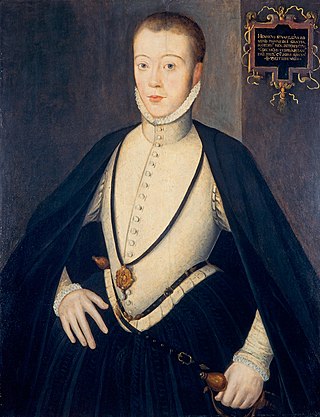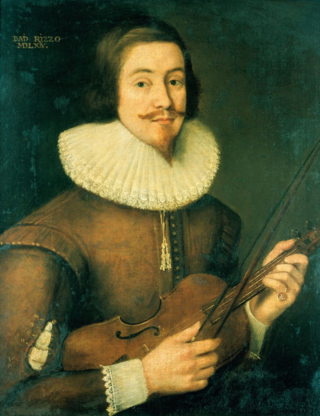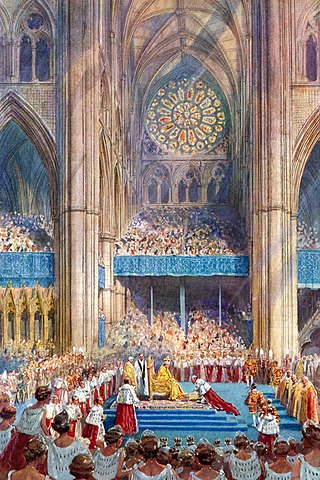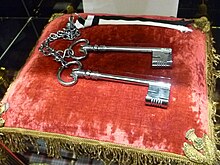
Henry Stuart, Lord Darnley, was the second husband of Mary, Queen of Scots, and the father of James VI of Scotland and I of England. Through his parents, he had claims to both the Scottish and English thrones, and from his marriage in 1565 he was king consort of Scotland. Less than a year after the birth of his son, Darnley was murdered at Kirk o' Field in 1567. Many contemporary narratives describing his life and death refer to him as simply Lord Darnley, his title as heir apparent to the Earldom of Lennox.

David Rizzio or Riccio was an Italian courtier, born in Pancalieri close to Turin, a descendant of an ancient and noble family still living in Piedmont, the Riccio Counts di San Paolo e Solbrito, who rose to become the private secretary of Mary, Queen of Scots. Mary's husband, Lord Darnley, is said to have been jealous of their friendship because of rumours that Rizzio had impregnated Mary, and he joined in a conspiracy of Protestant nobles to murder him, led by Patrick Ruthven, 3rd Lord Ruthven. Mary was having dinner with Rizzio and a few ladies-in-waiting when Darnley joined them, accused his wife of adultery and then had a group murder Rizzio, who was hiding behind Mary. Mary was held at gunpoint and Rizzio was stabbed numerous times. His body took 57 dagger wounds. The murder was the catalyst of the downfall of Darnley, and had serious consequences for Mary's subsequent reign.
The politics of Edinburgh are expressed in the deliberations and decisions of the City of Edinburgh Council, in elections to the council, the Scottish Parliament and the UK Parliament.

The State Opening of Parliament is a ceremonial event which formally marks the beginning of a session of the Parliament of the United Kingdom. It includes a speech from the throne known as the King's Speech. The event takes place in the House of Lords chamber on the first day of a new session, which is usually in May or June, and traditionally in November, but can occur at any time of year depending on the timing of General Elections and parliamentary session start dates. It takes place in front of both Houses of Parliament. The monarch, wearing the Imperial State Crown, reads a speech that has been prepared by his or her government outlining its plans for that parliamentary year. The most recent ceremony was held on 10 May 2022.

The coronation of the monarch of the United Kingdom is an initiation ceremony in which they are formally invested with regalia and crowned at Westminster Abbey. It corresponds to the coronations that formerly took place in other European monarchies, which have all abandoned coronations in favour of inauguration or enthronement ceremonies. A coronation is a symbolic formality and does not signify the official beginning of the monarch's reign; de jure and de facto their reign commences from the moment of the preceding monarch's death, maintaining legal continuity of the monarchy.

Holyrood Park is a royal park in central Edinburgh, Scotland about 1 mile to the east of Edinburgh Castle. It is open to the public. It has an array of hills, lochs, glens, ridges, basalt cliffs, and patches of gorse, providing a wild piece of highland landscape within its 650-acre (260 ha) area. The park is associated with the royal palace of Holyroodhouse and was formerly a 12th-century royal hunting estate. The park was created in 1541 when James V had the ground "circulit about Arthurs Sett, Salisborie and Duddingston craggis" enclosed by a stone wall.

George IV's visit to Scotland in 1822 was the first visit of a reigning monarch to Scotland in nearly two centuries, the last being by Charles II for his Scottish coronation in 1651. Government ministers had pressed the King to bring forward a proposed visit to Scotland, to divert him from diplomatic intrigue at the Congress of Verona.
The High Constables of Holyroodhouse are a small corps of ceremonial bodyguards at the Sovereign's official residence in the Scottish capital, Edinburgh. Created in the early sixteenth century to protect the Monarch in residence at Holyrood, as well as to guard the Palace and Abbey, and enforce law and order within the precincts of the Palace and the Holyrood Abbey Sanctuary.

The Right Honourable Lord Provost of Edinburgh is the convener of the City of Edinburgh local authority, who is elected by the city council and serves not only as the chair of that body, but as a figurehead for the entire city, ex officio the Lord-Lieutenant of Edinburgh and honorarily the Admiral of the Firth of Forth. It is the equivalent in many ways to the institution of Mayor that exists in many other countries.
The High Court of Constabulary was a court in Scotland presided over by the Lord High Constable of Scotland and other judges known as Constables-depute. The court had exclusive jurisdiction over crimes of rioting, disorder, bloodshed, and murder that took place within 4 miles (6.4 km) of the Monarch of Scotland, Privy Council of Scotland, or the Parliament of Scotland. It was established in the 13th century, and its de jure jurisdiction continued until at least the 19th century. From the 16th century the Constables-depute appear to have been the Lord Provosts, bailies, and Sheriffs of Edinburgh. Following the Treaty of Union of 1707, the Court had jurisdiction when the Monarch of Great Britain, and later the Monarch of the United Kingdom, was resident at the Palace of Holyrood House.

Holyrood is an area in Edinburgh, the capital of Scotland, lying east of the city centre, at the foot of the Royal Mile.
William Schaw was Master of Works to James VI of Scotland for building castles and palaces, and is claimed to have been an important figure in the development of Freemasonry in Scotland.

The Palace of Holyroodhouse, commonly referred to as Holyrood Palace or Holyroodhouse, is the official residence of the British monarch in Scotland. Located at the bottom of the Royal Mile in Edinburgh, at the opposite end to Edinburgh Castle, Holyroodhouse has served as the principal royal residence in Scotland since the 16th century, and is a setting for state occasions and official entertaining.

The City of Edinburgh Council is the local government authority covering the City of Edinburgh council area. The majority of the council area is the area of Edinburgh, capital of Scotland. With a population of 518,500 in mid-2019, it is the second most populous local authority area in Scotland.
The High Constables of Edinburgh are a prestigious body of constables, founded in 1611 and located in Edinburgh, Scotland. Historically, the High Constables were charged with policing the streets of Edinburgh, the capital city of Scotland, however today their duties are mostly ceremonial. It is believed that the High Constables of Edinburgh are the first example of a statutory police force in the world. At one time they formed part of the now defunct Corporation of the City of Edinburgh and continue to serve a ceremonial function in the local government of Edinburgh.
Sir John Stewart of Minto (1525–1583) was a Provost of Glasgow.

The Raid of Holyrood was an attack on Holyrood Palace, Edinburgh on 27 December 1591 by Francis Stewart, 5th Earl of Bothwell in order to gain the favour of King James VI of Scotland. Bothwell subsequently staged a raid at Falkland Palace, and in July 1593 made another attempt at Holyrood.

On 19 August 1561, the 18-year-old Mary, Queen of Scots, returned to Scotland from France following the death of her husband King Francis II of France the previous winter. On 2 September the town of Edinburgh organised a celebration of royal entry for her.
The Platinum Jubilee Act of Loyalty Parade was a military parade held at the Palace of Holyroodhouse in Edinburgh, Scotland on 28 June 2022, organised as part of the Queen's Platinum Jubilee celebrations. Performed as a tribute to the Queen as Head of the British Armed Forces, on behalf of all three branches of the British Armed Forces, it featured all three services, with each of the single service Senior Representatives in Scotland present, together with Service Cadets.













